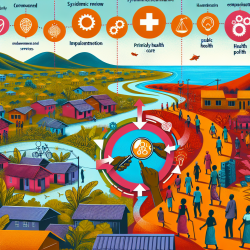Introduction
The recent study titled "Disparities in Air Pollutants Across Racial, Ethnic, and Poverty Groups at US Public Schools" by Cheeseman et al. (2022) sheds light on a critical issue affecting the health and educational outcomes of children across the United States. The research highlights how air pollution disproportionately impacts schools with higher populations of students from marginalized racial, ethnic, and socioeconomic backgrounds. As practitioners dedicated to improving child outcomes, it is imperative to consider these findings and explore how they can inform our practice and advocacy efforts.
Key Findings from the Research
The study reveals that schools with higher proportions of people of color (POC) and students eligible for the federal free or reduced lunch program, a proxy for poverty level, are associated with higher concentrations of air pollutants, specifically fine particulate matter (PM2.5) and nitrogen dioxide (NO2). For instance, the median annual NO2 concentration for White students nationally was 7.7 ppbv, compared to 9.2 ppbv for Black and African American students. These disparities are consistent across various states and regions, indicating a systemic issue that transcends local boundaries.
Furthermore, the research identifies distinct regional patterns, with notable differences between states such as California, New York, and Florida. The disparities are not limited to urban versus non-urban areas but are also present within urban environments, suggesting that localized factors contribute to these inequities.
Implications for Practitioners
As speech-language pathologists and other educational professionals, understanding the environmental context in which our students live and learn is crucial. The exposure to higher levels of air pollutants can have significant implications for cognitive and language development, potentially exacerbating existing disparities in educational outcomes. Here are several ways practitioners can address these challenges:
- Advocacy: Engage in advocacy efforts to address environmental injustices. This can include collaborating with local and national organizations to push for policy changes that reduce pollution in affected areas.
- Awareness and Education: Educate school communities, including parents, teachers, and administrators, about the impact of air pollution on children's health and learning. Increased awareness can lead to community-driven initiatives to improve air quality.
- Research and Collaboration: Encourage further research into the effects of air pollution on child development and learning. Collaborate with environmental scientists and public health experts to develop interventions that mitigate the impact of pollution on students.
- Program Development: Develop and implement programs that address the specific needs of students in high-pollution areas. This could include targeted interventions to support language and cognitive development.
Encouraging Further Research
The findings of Cheeseman et al. (2022) underscore the need for continued research into the intersection of environmental factors and educational outcomes. Practitioners are encouraged to contribute to this body of knowledge by conducting studies that explore the impact of air pollution on speech and language development. Collaborative efforts with researchers from other disciplines can lead to a more comprehensive understanding of these complex issues.
Conclusion
Addressing the disparities in air pollution exposure at US public schools is a crucial step toward achieving educational equity. As practitioners committed to creating positive outcomes for children, it is our responsibility to integrate these findings into our practice and advocacy efforts. By doing so, we can contribute to a healthier, more equitable future for all students.
To read the original research paper, please follow this link: Disparities in Air Pollutants Across Racial, Ethnic, and Poverty Groups at US Public Schools.










